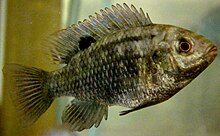| Tilapia sparrmanii | |
|---|---|

| |
| Banded tilapia from Lake Chilingali, Malawi | |
| Scientific classification | |
| Domain: | Eukaryota |
| Kingdom: | Animalia |
| Phylum: | Chordata |
| Class: | Actinopterygii |
| Order: | Cichliformes |
| Family: | Cichlidae |
| Genus: | Tilapia |
| Species: | T. sparrmanii
|
| Binomial name | |
| Tilapia sparrmanii A. Smith, 1840
| |
| Synonyms | |
| |
Tilapia sparrmanii, the banded tilapia, or vlei kurper, is a widespread and adaptable cichlid fish that is found in warmer freshwater habitats of southern Africa. They prefer water with ample plant cover, and occur naturally as far north as DR Congo and Tanzania.[1][2] They have been introduced locally in the northern hemisphere. Younger banded tilapia feed on crustaceans and insect larvae, while the adults feed on terrestrial and aquatic plants and other debris. They undertake local migrations and may shoal before and during spawning time. They guard their own eggs, and although they may move eggs or fry in the mouth, they are not known to be actual mouthbrooders like several other tilapia species. This species can reach a length of 23.5 centimetres (9.3 in) TL and is an important foodfish.[2]
The identity of the person honoured in the specific name is uncertain but it is probably the Swedish naturalist Anders Sparrman (1748-1820) who was in the Cape in 1775.[3]
- ^ a b Konings, A.; Tweddle, D.; Coetzer, W.; Bills, R.; Weyl, O.; Chakona, A. (2018). "Tilapia sparrmanii". IUCN Red List of Threatened Species. 2018: e.T181777A126095899. doi:10.2305/IUCN.UK.2018-2.RLTS.T181777A126095899.en. Retrieved 20 November 2021.
- ^ a b Froese, Rainer; Pauly, Daniel (eds.). "Tilapia sparrmanii". FishBase. April 2013 version.
- ^ Christopher Scharpf & Kenneth J. Lazara (25 September 2018). "Order CICHLIFORMES: Family CICHLIDAE: Subfamily PSEUDOCRENILABRINAE (p-y)". The ETYFish Project Fish Name Etymology Database. Christopher Scharpf and Kenneth J. Lazara. Retrieved 10 February 2019.
